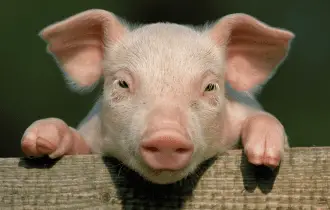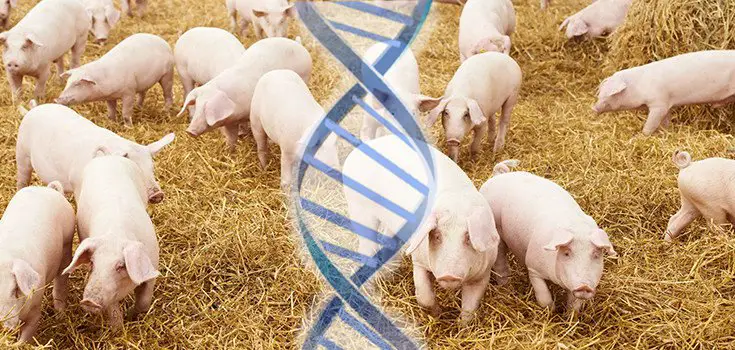February 16th, 2017
Contributing writer for Wake Up World
“Science is a good piece of furniture for a man to have in an upper chamber, provided he has common sense on the ground floor.” ~ Oliver Wendell Holmes
In Greek mythology, a chimera is a fire-breathing monster created from different species, most often portrayed as a creature with a lion’s head, a goat’s body and a serpent’s tail. Chimera have long been regarded as mythical creatures — to the extent that the word “chimera” also means “an illusion or fabrication of the mind” or “an unrealizable dream”1 — and the idea of a human-animal chimera has remained confined largely to mythology, however — until now.
First Human-Pig Hybrid Created
Researchers from the Salk Institute for Biological Studies in La Jolla, California, have made history by creating a human-pig hybrid, a task achieved by injecting days-old pig embryos with human pluripotent stem cells.2 Such cells, like embryonic stem cells, are able to divide indefinitely and become any type of cell in the body. The human-pig embryos were then transferred into adult pigs and allowed to grow for up to four weeks, before they were “removed and analyzed.”3
[pro_ad_display_adzone id=”110028″]
The study noted that more than 2,000 hybrid embryos were transferred into surrogate sows, but only 186 later-stage chimeric embryos survived the process, each with about 1 in 100,000 human cells.
The stated goal of such research is to figure out if it’s possible to grow human organs inside other species, like pigs. Human embryo development, drug development and disease processes could also be studied using chimeras.
Animal chimeras have been developed in the past. For instance, researchers genetically engineered (GE) rat embryos to not produce a pancreas (which controls blood sugar levels), then injected mouse stem cells into them, which resulted in the growth of pancreatic tissue. They were then able to treat diabetes by transplanting parts of the healthy organs into diseased mice.4
The development of human-animal chimeras has, however, remained in the realm of science fiction until now. Aside from the glaring ethical considerations, these types of experiments have been ineligible for public funding in the U.S., which is why the Salk Institute has had to rely on private funding for the study.5
US May Lift Funding Ban on Human-Animal Chimeras
In September 2015, the U.S. National Institutes of Health (NIH) issued a moratorium on funding research involving injecting human stem cells into animals.
While human cells have long been studied in animal models, such as growing human tumors in mice, “the new research is different, because potent human stem cells are being injected directly into a very early-stage animal embryo, consisting of just a couple of dozen cells,” MIT Technology Review reported. “Theoretically, the human cells could then end up contributing to any part of the animal, and in any amount.” 6
NIH was right to be wary, but by August 2016, they announced a plan to potentially lift the funding moratorium, noting that such experiments “are really important and exciting to understand how disease works.”7,8 In addition to forming a special committee to oversee funding of human-animal hybrid research, they announced that funding for research involving combining human cells with early ape or monkey embryos would continue to be forbidden.
The concern is that such research could inadvertently create a human-like ape, leading to consequences we’ve only begun to contemplate. As of January 2017, NIH’s funding ban is still in place, which certainly seems pragmatic, to put it mildly, given the risks involved. As MIT Technology Review pointed out:9
“The agency also wants to explicitly bar any of these human-animal chimeras from being allowed to reproduce.
The risk — very remote but which could have disastrous consequences for public confidence in science — is if two chimeras mated and gave rise to a human fetus. That could happen if their sperm or egg were human.”
Human-Animal Embryos: What Possibly Could Go Wrong?
The ability to grow human organs is undoubtedly an intriguing area of research, especially as about 76,000 Americans sit in wait of healthy organs for transplant.10 But the reality is that these GMO technologies may have unforeseen and devastating consequences — just like their predacessors. “The work inevitably raises the specter of intelligent animals with humanized brains and also the potential for bizarre hybrid creatures to be accidentally released into the wild,” The Guardian noted.11
Indeed, no one knows if inserting human cells into non-human animal embryos might lead to the creation of non-human animals with human consciousness. Neuroscientist Lori Marino, Ph.D., executive director of the Kimmela Center for Animal Advocacy, told STAT News:12
“These organisms may be capable of self-awareness to the extent that they understand their identity and circumstances, which would produce unbearable suffering. Will we know when the subjective experience of such a being has crossed the generally accepted line of decency and morality?
If we cannot say with certainty that this will never happen, then we need to stop this kind of research right now before we find ourselves in a world where there is no line.”
If organs can one day be grown inside animals, we’re then faced with the realities of whether this — raising animals for the sole purpose of organ harvesting — can and should be done, ethically speaking. It falls into the realm of research moving full-steam ahead before we’ve adequately stopped to consider whether we should move forward at all. Marino continued:13
“As we continue down the path of this unprecedented manipulation of sentient beings and pour funding into it, we simultaneously limit funding for alternative solutions to our health problems, including prevention, consensual human trials, incentives for organ donation, microchip testing and in vitro research.
All too soon, when we look back on the path of chimeric research that we’ve chosen, we may not like what we see. But by then it will be too late.”
Challenges to Chimera Research
Some of the more unsettling questions raised in combining human stem cells with pig embryos include whether the resulting progeny may resemble humans more than pigs, or whether the human cells could overtake the pig cells, resulting in an offspring that’s mostly human but “slightly pig.”14 Other issues include the differing rates of embryonic development in different species. Pig pregnancies are much shorter than human pregnancies, for instance, so for the Salk Institute study to be successful, the researchers had to inject the human stem cells at exactly the right phase in development.
It was an experiment four years and 40 people in the making, with lead author professor Juan Carlos Izpisua Belmonte, Ph.D., of the Salk Institute’s Gene Expression Laboratory, noting “We underestimated the effort involved.”15
Although it’s thought the human cells were only involved in the formation of muscle, and no human cells were observed in the brain region, Belmonte noted “we cannot exclude the possibility that they may have gone to the [pig] brain.”16
Next, the researchers plan to genetically edit the pig embryos, which is being made increasingly possible via technology like the gene-editing tool CRISPR, to “delete” organs in the hopes that injected human stem cells will then take over to create human organs inside the pigs.
[pro_ad_display_adzone id=”110030″]
Gene-Edited Foods Are Already Here
CRISPR gene-editing technology has been taking the medical world by storm, but lesser known is that CRISPR and other gene-editing tools are also being used in the food industry. Gene-edited crops, in which DNA is tweaked or snipped out at a precise location, have already been created — and eaten.
The New York Times reported on the first dinner on Earth with gene-edited foods, including soybeans and potato produced by a pharmaceutical company called Cellectis. Unlike genetically engineered foods, which may have genes from other species inserted:
“There is nothing taken out or added to the plant,” André Choulika, Ph.D., chief executive of Cellectis, told the Times. “It’s what nature would have produced.”17
It’s too soon to say what gene editing may do to food and the environment, for better or for worse, but, as is the case with human-pig chimeras, the technology is already forging ahead, so we’ll inevitably find out, sooner or later.
Foods produced via gene-editing are not subject to regulation by the U.S. Department of Agriculture (although an advisory board recommended gene-edited foods could not be labeled organic) or other regulatory agencies. “They, at least for now, largely fall outside of current regulations,” the Times reported.18
To date, the technology has been used to produce soybeans with altered fatty acid profiles, potatoes that take longer to turn brown, and potatoes that remain fresher longer and do not produce carcinogens when fried. The latter could be sold commercially as early as 2019.
What Does the Future Hold?
You may remember that in 1996, Dolly the sheep was born. She was the first mammal to be cloned from an adult cell, a Scottish creation of science “born” to three mothers (one that provided the egg, the other the DNA and a third that carried the cloned embryo until birth).
Many are not aware that, in 1997, the same Scottish researchers who created Dolly created a cloned sheep, named Polly, and four near-identical sisters with a human gene “of therapeutic value.”19 The move was said to pave the way for the creation of a technique that could eventually make replacement organs a reality, and now, 20 years later, we’re standing on the edge of this seemingly no-longer-theoretical precipice.
As is often the case with technology, however, science is moving faster than the moral implications can be considered, much less understood. David King, Ph.D., director of the secular watchdog group Human Genetics Alert, summed it up in The Telegraph, stating:20
“I find these experiments disturbing … In mythology human-animal chimeras were frightening monsters for good reason. I don’t recall these scientists asking for the public’s opinion before going ahead with such experiments.”
- 1 Merrian-Webster, Chimera
- 2 Cell January 26, 2017
- 3, 5 National Geographic January 26, 2017
- 4 Nature January 25, 2017
- 6, 7, 9 MIT Technology Review August 4, 2016
- 8 National Institutes of Health August 4, 2016
- 10 The New York Times January 26, 2017
- 11, 14, 16 The Guardian January 26, 2017
- 12, 13 STAT News January 26, 2017
- 15, 20 The Telegraph January 26, 2017
- 17, 18 The New York Times January 9, 2017
- 19 The Irish Times July 25, 1997
About the author:
 Born and raised in the inner city of Chicago, IL, Dr. Joseph Mercola is an osteopathic physician trained in both traditional and natural medicine. Board-certified in family medicine, Dr. Mercola served as the chairman of the family medicine department at St. Alexius Medical Center for five years, and in 2012 was granted fellowship status by the American College of Nutrition (ACN).
Born and raised in the inner city of Chicago, IL, Dr. Joseph Mercola is an osteopathic physician trained in both traditional and natural medicine. Board-certified in family medicine, Dr. Mercola served as the chairman of the family medicine department at St. Alexius Medical Center for five years, and in 2012 was granted fellowship status by the American College of Nutrition (ACN).
While in practice in the late 80s, Dr. Mercola realized the drugs he was prescribing to chronically ill patients were not working. By the early 90s, he began exploring the world of natural medicine, and soon changed the way he practiced medicine.
In 1997 Dr. Mercola founded Mercola.com, which is now routinely among the top 10 health sites on the internet. His passion is to transform the traditional medical paradigm in the United States. “The existing medical establishment is responsible for killing and permanently injuring millions of Americans… You want practical health solutions without the hype, and that’s what I offer.”
Visit Mercola.com for more information, or read Dr. Mercola’s full bio and résumé here.
Recommended articles by Dr. Joseph Mercola:
- Real Rehabilitation – The Benefits of Organic Gardening in Prisons
- Essential Oils Can Help Ease Symptoms of ADHD
- Medical Errors: Still the Third Leading Cause of Death
- Battered Bees and the Threat to Our Food Supply
- Plants Are Smarter Than You Think
- Scientific Links Between Processed Foods and Depression
- How Sugar Harms Your Brain Health and Drives Alzheimer’s Epidemic
- The Health Benefits of Intermittent Fasting
- Can a Hug a Day Keep Infection Away?
- The Magic Healing Power of Mushrooms
- The Science of Healing Thoughts
- Caring for an Aging or Dying Pet – What You Need to Know (and Some Help with Your Grief)
[pro_ad_display_adzone id=”110027″]








